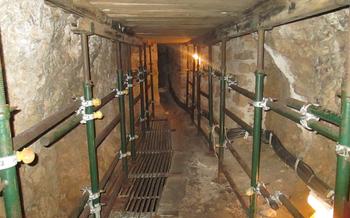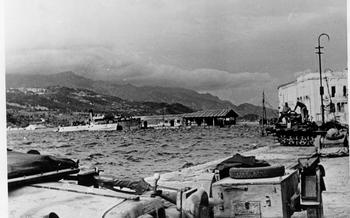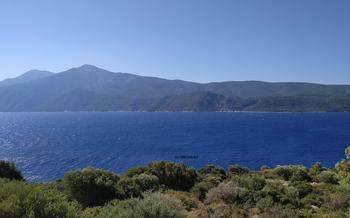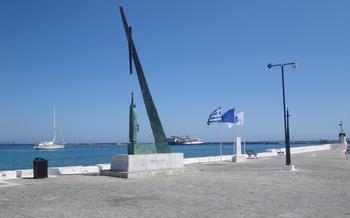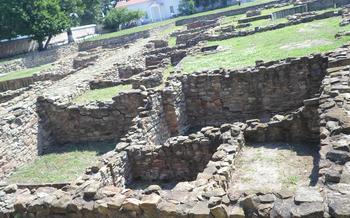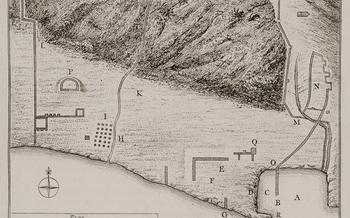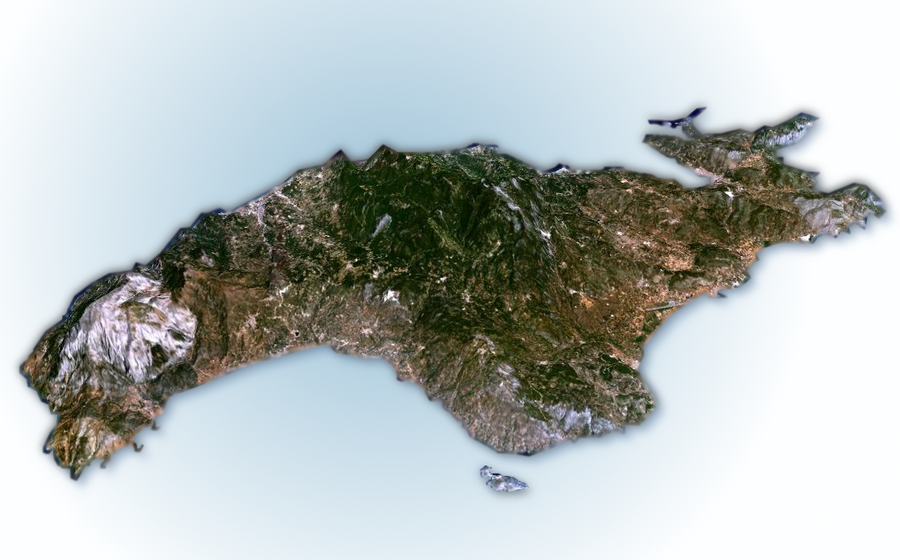
Archaeological Museum of Pythagorion
- Historical Significance
- Architectural Marvels
- Exquisite Artifacts
- Interactive Exhibits
- Temporary Exhibitions
- Educational Programs
- Accessibility
- Visitor Information
- Location
- Nearby Attractions
- Photography
- Souvenirs
- Insider Tip: Unveiling the Secrets of Samos
Historical Significance
Journey back in time to the birthplace of the legendary mathematician and philosopher Pythagoras, in the ancient city of Pythagoreion on the island of Samos. Explore the fascinating history of this city-state, which flourished in the Hellenistic period as a center of commerce, culture, and science. Discover the influence of Pythagoras' teachings on mathematics, philosophy, and science, which have left an enduring legacy that continues to shape our understanding of the world today.
Architectural Marvels
The Archaeological Museum of Pythagorion is not only a treasure trove of artifacts but also a testament to the architectural ingenuity of the ancient Samians. The museum's building, designed by renowned Greek architect Aris Konstantinidis, seamlessly blends ancient and modern elements, creating a harmonious dialogue between the past and the present.
The exterior of the museum is a sight to behold, with its clean lines, geometric shapes, and use of local stone. The imposing facade, reminiscent of an ancient temple, hints at the wonders that lie within. Upon entering the museum, visitors are greeted by a spacious and well-lit atrium, where natural light floods in through large windows, illuminating the exhibits.
The museum's layout is designed to enhance the visitor experience, with spacious galleries arranged around the central atrium. Each gallery is dedicated to a specific era or aspect of Samian history, and the exhibits are arranged in a logical and informative manner. The museum also features a state-of-the-art auditorium, where visitors can attend lectures, workshops, and film screenings.
Beyond the museum's walls, visitors can explore the remarkably preserved ruins of the ancient city of Pythagorion. The city's fortifications, temples, and public buildings stand as testaments to the skill and artistry of the ancient Samians. The Temple of Hera, with its impressive columns and intricate carvings, is a must-see for any visitor interested in ancient Greek architecture.
The unique features of Samian architecture are evident throughout the site, showcasing the innovative techniques and materials used by the ancient builders. The use of local stone, quarried from the nearby hills, gives the buildings a warm and earthy feel. The construction techniques employed, such as the use of corbelled arches and vaulted roofs, demonstrate the engineering prowess of the Samians.
Exploring the architectural wonders of the Archaeological Museum of Pythagorion and the ancient city of Pythagorion is a journey through time, allowing visitors to admire the enduring legacy of Samian craftsmanship and innovation.
Exquisite Artifacts
The Archaeological Museum of Pythagorion houses an impressive collection of artifacts that provide a glimpse into the rich history and culture of ancient Samos. Among the notable exhibits, the Kouros of Pythagoras, a well-preserved marble statue depicting the young philosopher, stands as a testament to the island's artistic prowess. The bronze statue of Hermes, with its intricate details and lifelike expression, showcases the mastery of ancient Greek sculptors. The museum also boasts a remarkable collection of exquisite gold jewelry, adorned with intricate designs and precious gemstones, offering insights into the wealth and opulence of ancient Samian society.
These artifacts, carefully curated and displayed, provide a tangible connection to the past, allowing visitors to appreciate the craftsmanship and artistic traditions of ancient Samos. They illustrate the island's role as a cultural and economic center, where skilled artisans created works of art that transcended time and continue to inspire awe and admiration.
Interactive Exhibits
The Archaeological Museum of Pythagorion brings ancient Samos to life through its innovative use of interactive displays and multimedia presentations. These exhibits are not just visually appealing but also educational, making history and culture accessible to visitors of all ages.
Explore the interactive timeline that takes you on a journey through the history of Samos, from its humble beginnings to its rise as a prominent city-state. Touchscreens and virtual reality experiences allow you to virtually walk through the ancient city, witnessing its bustling streets, temples, and fortifications.
At the "Sounds of Samos" exhibit, don headphones and listen to the recreated sounds of ancient Samos. Imagine the city's harbor filled with the clamor of merchants, the clinking of pottery, and the lively music of festivals.
The museum also features interactive games and puzzles that challenge your knowledge of Samian history and culture. Test your skills at decoding ancient inscriptions, playing traditional Samian games, or solving puzzles related to Pythagoras' mathematical discoveries.
During my visit, I was particularly drawn to the interactive exhibit on Pythagoras' theorem. Using a touch screen, I explored different proofs of the theorem and even experimented with creating my own shapes to see how they fit the Pythagorean relationship. It was a fun and engaging way to learn about one of the most famous mathematical concepts in history.
The Archaeological Museum of Pythagorion's interactive exhibits are not just about entertainment; they are powerful tools for education and engagement. They allow visitors to immerse themselves in ancient Samian culture, making history come alive in a way that traditional displays simply cannot.
Temporary Exhibitions
The Archaeological Museum of Pythagorion regularly hosts temporary exhibitions that showcase special collections, collaborations with other institutions, and contemporary art. These exhibitions add a dynamic and ever-changing dimension to the museum's offerings, allowing visitors to explore new perspectives on Samos' history and culture.
One of the highlights of the museum's temporary exhibition program is the annual "Pythagorion Symposium," which brings together scholars and experts from around the world to discuss the life and teachings of Pythagoras. This symposium provides a unique opportunity for visitors to engage with cutting-edge research and gain insights into the enduring influence of Pythagorean philosophy.
Another notable temporary exhibition was "Treasures of the Sea: Shipwrecks and Maritime Archaeology in Samos," which showcased a collection of artifacts recovered from ancient shipwrecks around the island. This exhibition highlighted the importance of maritime trade and exploration in Samos' history and featured stunningly preserved artifacts such as amphorae, jewelry, and tools.
The museum also collaborates with contemporary artists to present thought-provoking exhibitions that explore themes related to Samos' heritage and identity. These exhibitions often spark conversations about the relationship between past and present, and challenge visitors to think critically about the island's rich cultural legacy.
By hosting temporary exhibitions, the Archaeological Museum of Pythagorion demonstrates its commitment to promoting contemporary art and cultural exchange. These exhibitions offer visitors a chance to experience the museum's collection in new and unexpected ways, and to gain a deeper understanding of Samos' diverse and evolving cultural landscape.
Educational Programs
The Archaeological Museum of Pythagorion is committed to public outreach and education, offering a range of educational programs for visitors of all ages. These programs aim to deepen the understanding of Samos' rich history and culture, making the museum a valuable resource for students, lifelong learners, and anyone interested in exploring the island's heritage.
One of the highlights of the museum's educational offerings is the guided tours. Led by knowledgeable and passionate docents, these tours provide an in-depth exploration of the museum's exhibits, shedding light on the significance of the artifacts and the stories they tell. Visitors can choose from a variety of tour options, tailored to different interests and age groups, ensuring a personalized and enriching experience.
In addition to guided tours, the museum also organizes workshops, lectures, and educational events throughout the year. These programs cover a wide range of topics related to Samian history, archaeology, and culture, inviting experts and scholars to share their knowledge with the public. Whether it's a workshop on ancient pottery techniques or a lecture on the life and teachings of Pythagoras, these events offer a unique opportunity to engage with experts and delve deeper into the fascinating world of Samos.
For students, the museum provides educational materials and resources to support their studies. These resources include educational guides, interactive activities, and online resources that make learning about Samos' history both fun and informative. The museum also collaborates with local schools to develop educational programs that align with the school curriculum, ensuring that students have access to quality historical and cultural education.
My personal experience with the museum's educational programs was truly enriching. I participated in a guided tour that brought to life the stories behind the artifacts, giving me a deeper appreciation for the rich cultural heritage of Samos. I also attended a workshop on ancient Greek pottery, where I had the opportunity to learn about the techniques and traditions of Samian pottery firsthand. These experiences not only enhanced my understanding of Samos' history but also sparked a passion for lifelong learning.
Accessibility
The Archaeological Museum of Pythagorion is committed to providing an inclusive and accessible environment for all visitors, regardless of their abilities or disabilities. The museum features a range of accessibility features to ensure that everyone can enjoy and learn from its exhibits.
Wheelchair ramps and elevators provide easy access to all levels of the museum, allowing visitors with mobility challenges to navigate the galleries comfortably. Braille signage throughout the museum assists visually impaired visitors in exploring the exhibits.
The museum staff is also trained to provide assistance and support to visitors with disabilities. They can offer guidance, provide information in accessible formats, and arrange for sign language interpreters upon request.
With its commitment to accessibility, the Archaeological Museum of Pythagorion strives to create a welcoming and inclusive space for all visitors, ensuring that everyone has the opportunity to engage with and appreciate the rich history and culture of Samos.
Visitor Information
The Archaeological Museum of Pythagorion welcomes visitors throughout the year. It is typically open from Tuesday to Sunday, with varying hours depending on the season. Admission fees are reasonable, and guided tours are available in multiple languages for a more immersive experience. The museum offers a range of amenities to enhance your visit, including a well-stocked gift shop where you can purchase souvenirs, books, and replicas of artifacts. There is also a cafeteria on-site where you can grab a bite to eat or enjoy a refreshing beverage.
To make the most of your visit, plan your trip during the shoulder seasons (spring or fall) to avoid the summer crowds. This will allow you to explore the museum at a more leisurely pace and truly appreciate the exhibits. Remember to wear comfortable shoes as you will be doing a lot of walking on uneven surfaces. It's also a good idea to bring along a camera to capture the many photo-worthy moments.
The museum is conveniently located in the heart of Pythagorion, within walking distance of other attractions, shops, and restaurants. It is easily accessible by public transportation, with bus stops nearby. If you're driving, there is ample parking available in the vicinity.
Location
The Archaeological Museum of Pythagorion is strategically situated in the heart of the picturesque town of Pythagorion, on the eastern coast of Samos. Its prime location allows visitors to seamlessly integrate their museum visit with a captivating exploration of the town's rich history and vibrant atmosphere. The museum is easily accessible by foot, inviting visitors to stroll through the charming streets of Pythagorion, lined with traditional Greek tavernas, quaint shops, and historical landmarks. Additionally, the museum's proximity to the picturesque harbor provides visitors with the opportunity to combine their cultural immersion with a delightful boat trip or a leisurely walk along the scenic waterfront.
Nearby Attractions
Beyond the treasures of the Archaeological Museum of Pythagorion, Samos boasts a wealth of nearby attractions that offer a diverse range of experiences. History buffs can delve deeper into the island's past at the Eupalinian Aqueduct, an engineering marvel that dates back to the 6th century BC and still stands as a testament to ancient Greek ingenuity. Nature enthusiasts can embark on a scenic hike through the Potami Waterfalls, surrounded by lush vegetation and cascading waters. For those seeking a taste of local culture, the nearby village of Kokkari beckons with its charming streets, traditional tavernas, and picturesque harbor. Whether you prefer exploring ancient ruins, immersing yourself in natural beauty, or savoring the flavors of Samian cuisine, the island has something to offer every traveler.
Insider Tip: For a truly unique experience, time your visit to Samos to coincide with one of the island's many festivals. These vibrant celebrations showcase local traditions, music, and dance, offering a glimpse into the heart and soul of Samian culture.
Photography
The Archaeological Museum of Pythagorion welcomes photography enthusiasts to capture the beauty and significance of its exhibits. Visitors are encouraged to take photos for personal use, creating lasting memories of their visit. However, to ensure the preservation and respect of the artifacts, flash photography is not permitted. Using a tripod is also prohibited to minimize any potential disturbances to other visitors.
For those who wish to share their photos on social media or through the museum's website, the museum encourages the use of the hashtag #ArchaeologicalMuseumofPythagorion. This allows the museum to connect with visitors and create a vibrant online community around its collections. By sharing their experiences and perspectives, visitors contribute to the museum's efforts to promote the rich cultural heritage of Samos.
Souvenirs
The Archaeological Museum of Pythagorion offers a well-stocked gift shop where visitors can purchase souvenirs and mementos to commemorate their visit. The shop features a diverse collection of items, including replicas of ancient artifacts, books on Samian history and culture, postcards featuring stunning photographs of the museum and its exhibits, and a variety of locally-made crafts.
Among the most popular souvenirs are miniature replicas of the Kouros of Pythagoras, the bronze statue of Hermes, and other iconic artifacts from the museum's collection. These replicas are meticulously crafted and make for excellent gifts or personal keepsakes. Visitors can also find a selection of books that delve deeper into the history and culture of Samos, providing a lasting educational resource for those who want to continue exploring the island's rich heritage.
For those seeking unique and authentic souvenirs, the gift shop offers a range of locally-made crafts and products. Visitors can choose from colorful ceramics and pottery, handwoven textiles, and intricate jewelry inspired by ancient Samian designs. These handcrafted items not only serve as souvenirs but also support local artisans and help preserve traditional Samian craftsmanship.
My personal recommendation is the exquisite gold jewelry, which is a replica of pieces found in ancient Samian tombs. These replicas are beautifully crafted and make for a truly special and memorable souvenir.
Whether you choose to purchase a replica artifact, a book about Samian history, a locally-made craft, or simply a postcard, the gift shop at the Archaeological Museum of Pythagorion offers a variety of unique and meaningful souvenirs that will remind you of your visit to this fascinating island.
Insider Tip: Unveiling the Secrets of Samos
Beyond the captivating exhibits and historical narratives, the Archaeological Museum of Pythagorion holds a hidden gem that awaits curious and adventurous visitors. In the heart of the museum, tucked away in a secluded corner, lies a mysterious artifact known as the "Samos Sphinx." This enigmatic sculpture, carved from local marble, depicts a mythical creature with the body of a lion and the head of a woman. Its origins and significance remain shrouded in mystery, sparking the imagination of archaeologists and visitors alike.
As you stand before the Samos Sphinx, allow yourself to be transported back in time. Imagine the skilled artisans who meticulously crafted this masterpiece, imbuing it with both power and grace. Reflect on the ancient myths and legends that surround the sphinx, creatures that guarded sacred knowledge and protected hidden treasures.
The Samos Sphinx serves as a reminder that the museum's collection is not merely a display of historical artifacts but a portal to a world of untold stories and mysteries. Embrace the opportunity to explore the museum with an open mind and a sense of curiosity, and you may just uncover your own hidden treasure among its many wonders.
